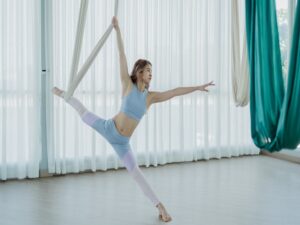Hanging Leg Raises are one of the top choices to add to your workout program. It comes to isolated workouts that target your abdominals. A fantastic exercise to strengthen your upper body, especially your neck, back, and hamstrings, is hanging leg raises. It strengthen the muscles and gives mobility and functional resilience to your core muscles. Hanging leg lifts are ideal if your exercise objective is to increase core power and enhance leg shape.
Meaning of Hanging Leg Raises
It is hanging leg lifts, grasping a pull rope, and elevating your core strength. It is skill-related fitness off the floor in a controlled motion, and it is by the involvement of your abs. The lower abs can be challenging to engage with other strength training. It is by hanging leg raises, when performed correctly, that can improve core stability. While strengthening your grip lifts can work the musculature. It is in your hip flexors and lower spine.
How to Properly Perform Hanging Leg Raises
Before performing hanging leg lifts, take into account these suggestions.
Make progress toward it.
The intermediate ab workout that calls for upper body strength and balance is exercise. It is attempting it before. Try doing sit-ups, reversed sit-ups, or bent-knee leg raises on your back.
Begin by bending your knees.
Straighten bowed legs can be hanging leg lifts. Begin with a bent knee variant first, and taxe your quadriceps and lower back muscles.
Retain power over your motion.
Using speed to propel you during the dangling leg lift is one of the common blunders people make. Raise your legs slowly while maintaining core stability. Think about a captain chair at your neighborhood gym. If you’re having trouble maintaining balance. The equipment enables you to rest on your elbows rather than holding from a pull rack.
Continue to tilt your pelvis backward.
Maintain a posterior pelvic tilt with your legs in front of you throughout the exercise. It safeguards your tailbone. Your stomach muscles will remain active in this position.
Consider modifying.
Recommend introducing a free weight across your toes. It is such as a barbell or kettlebell, once you have practiced. It is by lifting your weight during the hanging leg raise to promote thigh engagement.
Variations of Hanging Leg Raises
The easy ways to hang leg raises are the following:
Suspended Raise with Bent Legs
Practice the bent leg variation if you have trouble raising your good posture. Push your knees to your belt. They are 90 degrees bent using your core and hip flexor digitorum. Concentrate on your stretched legs till your knees are at your waist. It is then lowering them as your stamina grows.
Leg Raise for Captain Seat
The captain sitting leg raise is an additional, marginally simpler variation of the hanging leg lift. The seat and arm cushions on this chair assist you in seated. Raise your extended legs ahead of you and then drop them again. It is while resting your forearms on the backrest and your hands on the grips.
Assisted Heavy Leg Raise
You can also add ankle weights when you are ready to advance. It is by hanging leg lifts while holding a dumbbell or healthcare ball between your feet. If you employ this modification, pick a weight that can lift without compromising your technique. Hold it firmly between your toes.
Leg Raise with Shoulder-Level Hang
Keep elevating your legs until they are shoulder height. The deltoid has to work to make the workout more challenging. The variation should only be if you can maintain a suitable type.
Hanging Leg Raise with One Bicep
An advanced variation is one-arm hanging leg lifts with straight or bent knees. You merely hang from one arm rather than two, but the movements are the same. You might avoid this if it puts too much strain on your wrists or elbows.
Advantages of Hanging Leg Raises
They are the following:
- Even though they are for strengthening the core, hanging leg lifts have many other advantages. They are the ideal option for your grip. It is similar to free hanging in that the body remains suspended above the surface. It is only by the strength of your palm, wrist, and elbow.
- They improve the balance and flexibility of the shoulders. Most people spend the day with their arms underneath their heads. It might be typing, turning the wheel, or talking on the phone. Your shoulders can extend, grow strong, and breathe in a hanging posture. It is a routine workout to correct upper body position and strengthen the shoulders.
- There is good news for those of us who are prone to backaches. Leg raises while hanging can ease the pain. All of your limbs are under pressure when you are hanging freely. It allows the muscles, tendons, and ligaments to relax. Your spine discs extend and loosen, relieving the back pressure. One of the strategies for overcoming back pain is to stretch your back when extended.
- You can concentrate on tightening your abdominal muscles with the hanging leg raise. It is rather than just raising your lower body into the air. To focus your attention firmly on your core throughout the action, you must learn how to lock it.
Typical Problems
The secret to mastering hanging leg lifts is to be in complete control. One typical error is raising your legs and using motion instead of your abs to lift your legs. Another is letting your legs drop too rapidly, preventing your abs from being used in the second portion. Others include leaning at the elbows, the knees, and the backbone. It is like bending at the knees and the lower back. Given how challenging the exercise is, it is inevitable that occasionally our form shaky. It is if we are new to the practice.
Final Words
It is if your exercise objective is to increase strength and endurance, hip flexor movement, and shoulder stabilization. Hanging leg raises will enhance your workout. Initiate with

